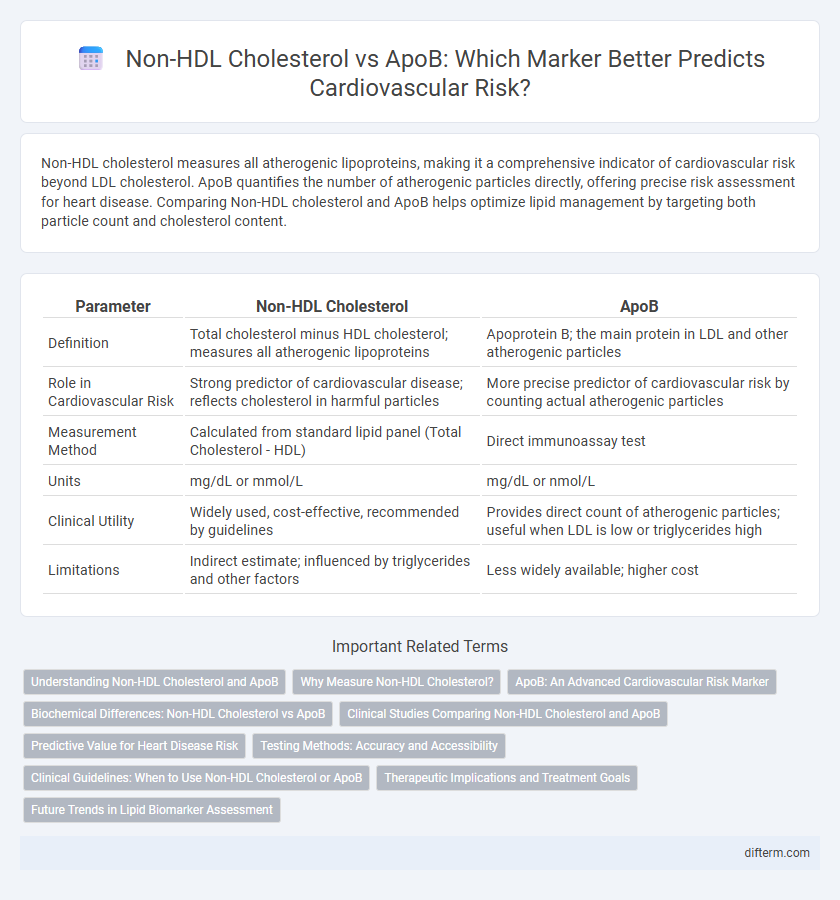Non-HDL cholesterol measures all atherogenic lipoproteins, making it a comprehensive indicator of cardiovascular risk beyond LDL cholesterol. ApoB quantifies the number of atherogenic particles directly, offering precise risk assessment for heart disease. Comparing Non-HDL cholesterol and ApoB helps optimize lipid management by targeting both particle count and cholesterol content.
Table of Comparison
| Parameter | Non-HDL Cholesterol | ApoB |
|---|---|---|
| Definition | Total cholesterol minus HDL cholesterol; measures all atherogenic lipoproteins | Apoprotein B; the main protein in LDL and other atherogenic particles |
| Role in Cardiovascular Risk | Strong predictor of cardiovascular disease; reflects cholesterol in harmful particles | More precise predictor of cardiovascular risk by counting actual atherogenic particles |
| Measurement Method | Calculated from standard lipid panel (Total Cholesterol - HDL) | Direct immunoassay test |
| Units | mg/dL or mmol/L | mg/dL or nmol/L |
| Clinical Utility | Widely used, cost-effective, recommended by guidelines | Provides direct count of atherogenic particles; useful when LDL is low or triglycerides high |
| Limitations | Indirect estimate; influenced by triglycerides and other factors | Less widely available; higher cost |
Understanding Non-HDL Cholesterol and ApoB
Non-HDL cholesterol measures all atherogenic lipoproteins, including LDL, VLDL, and intermediate-density lipoproteins, providing a comprehensive risk assessment for cardiovascular disease. Apolipoprotein B (ApoB) quantifies the number of atherogenic particles directly, reflecting the total count of potentially harmful lipoproteins. Understanding both non-HDL cholesterol and ApoB enhances risk stratification and guides more targeted lipid-lowering therapy.
Why Measure Non-HDL Cholesterol?
Non-HDL cholesterol is a crucial marker for assessing cardiovascular risk because it encompasses all atherogenic lipoproteins, including LDL, VLDL, and IDL, providing a more comprehensive risk profile than LDL cholesterol alone. Measuring Non-HDL cholesterol is especially valuable in patients with elevated triglycerides where LDL levels may be underestimated. Compared to ApoB, Non-HDL cholesterol is easier and less costly to measure while still strongly correlating with cardiovascular events, making it a practical choice for routine clinical screening.
ApoB: An Advanced Cardiovascular Risk Marker
ApoB, representing the total number of atherogenic lipoprotein particles, is a superior cardiovascular risk marker compared to non-HDL cholesterol because it directly measures particle count rather than cholesterol content. Unlike non-HDL cholesterol, which includes various lipoproteins like LDL and VLDL, ApoB quantifies the actual risk by reflecting the total number of lipoproteins contributing to plaque formation. Clinical studies demonstrate that elevated ApoB levels correlate strongly with increased risk of heart disease, making it an advanced and precise tool for cardiovascular risk assessment.
Biochemical Differences: Non-HDL Cholesterol vs ApoB
Non-HDL cholesterol measures the total cholesterol content in all atherogenic lipoproteins, including LDL, VLDL, and IDL, whereas ApoB quantifies the number of these lipoprotein particles directly by counting each particle's apolipoprotein B-100 protein. Biochemically, non-HDL cholesterol reflects the lipid mass within these particles, while ApoB provides a more precise assessment of particle concentration and atherogenic risk since each atherogenic particle contains one ApoB molecule. This distinction allows ApoB to serve as a superior marker for cardiovascular risk prediction by capturing particle number rather than just lipid content.
Clinical Studies Comparing Non-HDL Cholesterol and ApoB
Clinical studies comparing non-HDL cholesterol and ApoB consistently demonstrate that ApoB provides a more precise assessment of atherogenic particle number, correlating strongly with cardiovascular risk. Non-HDL cholesterol measures the total cholesterol contained in all atherogenic lipoproteins, yet ApoB quantifies the actual number of these particles, offering superior predictive value for cardiovascular events. Research published in journals like the Journal of the American College of Cardiology indicates that ApoB-guided therapy results in better risk stratification and improved clinical outcomes in patients with dyslipidemia.
Predictive Value for Heart Disease Risk
Non-HDL cholesterol measures all atherogenic lipoproteins, providing a comprehensive risk indicator for cardiovascular disease, while ApoB specifically quantifies the number of atherogenic particles, offering superior precision in predicting heart disease risk. Studies show ApoB levels correlate more strongly with plaque formation and cardiovascular events compared to non-HDL cholesterol. Incorporating ApoB measurement into routine lipid profiling enhances risk stratification, particularly in patients with metabolic syndrome or diabetes.
Testing Methods: Accuracy and Accessibility
Non-HDL cholesterol testing measures all atherogenic lipoproteins by subtracting HDL cholesterol from total cholesterol, offering a cost-effective and widely accessible screening method. ApoB testing quantifies the number of atherogenic particles with higher accuracy, providing better prediction of cardiovascular risk, especially in patients with complex lipid profiles. While ApoB assays require specialized laboratory equipment and are less available in routine clinical settings, non-HDL cholesterol remains a practical initial marker due to its ease of measurement and established clinical guidelines.
Clinical Guidelines: When to Use Non-HDL Cholesterol or ApoB
Clinical guidelines recommend using non-HDL cholesterol as a primary marker for assessing cardiovascular risk in routine lipid profiles due to its ability to capture all atherogenic lipoproteins. ApoB measurement is advised for patients with metabolic syndrome, diabetes, or hypertriglyceridemia, where non-HDL cholesterol may underestimate risk. The selection between non-HDL cholesterol and ApoB depends on specific patient risk profiles and the clinical scenario to optimize cardiovascular disease prevention strategies.
Therapeutic Implications and Treatment Goals
Non-HDL cholesterol provides a comprehensive measure of all atherogenic lipoproteins, correlating closely with cardiovascular risk and serving as a reliable target for lipid-lowering therapy. ApoB, reflecting the total number of atherogenic particles, offers superior precision in risk stratification, especially in patients with discordant lipid profiles or metabolic disorders. Therapeutic goals should prioritize lowering ApoB levels to reduce particle number and non-HDL cholesterol to minimize atherogenic cholesterol burden, optimizing cardiovascular outcomes through individualized treatment strategies.
Future Trends in Lipid Biomarker Assessment
Future trends in lipid biomarker assessment emphasize the integration of non-HDL cholesterol and ApoB measurements to enhance cardiovascular risk prediction. Emerging evidence shows ApoB offers a more precise quantification of atherogenic particles, potentially surpassing non-HDL cholesterol in guiding personalized treatment strategies. Advances in high-throughput assays and artificial intelligence are expected to facilitate routine ApoB testing, driving a shift toward more comprehensive and accurate lipid profiling in clinical practice.
Non-HDL Cholesterol vs ApoB Infographic

 difterm.com
difterm.com